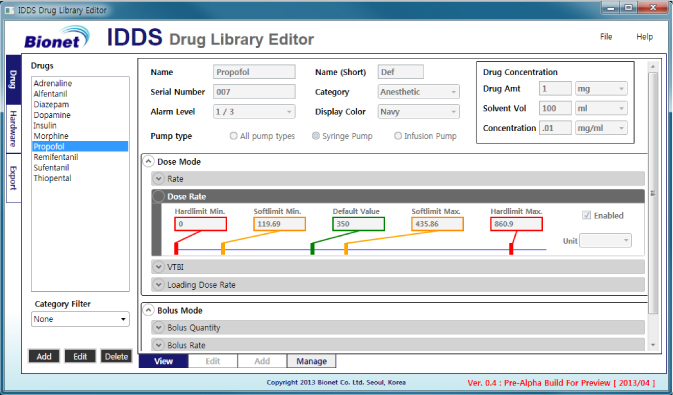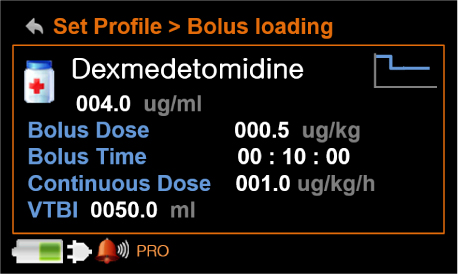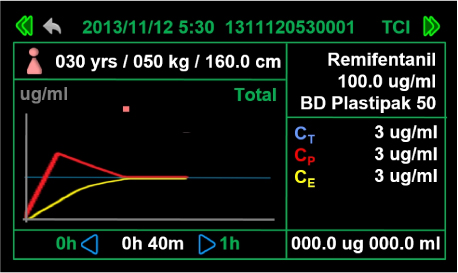J Dent Anesth Pain Med.
2016 Sep;16(3):165-173. 10.17245/jdapm.2016.16.3.165.
Smart syringe pumps for drug infusion during dental intravenous sedation
- Affiliations
-
- 1Department of Dental Anesthesiology, School of Dentistry, Seoul National University, Seoul, Korea. stone90@snu.ac.kr
- 2R&D Center, Bionet Co., Ltd, Seoul, Korea.
- KMID: 2354651
- DOI: http://doi.org/10.17245/jdapm.2016.16.3.165
Abstract
- Dentists often sedate patients in order to reduce their dental phobia and stress during dental treatment. Sedatives are administered through various routes such as oral, inhalation, and intravenous routes. Intravenous administration has the advantage of rapid onset of action, predictable duration of action, and easy titration. Typically, midazolam, propofol or dexmedetomidine are used as intravenous sedatives. Administration of these sedatives via infusion by using a syringe pump is more effective and successful than infusing them as a bolus. However, during intravenous infusion of sedatives or opioids using a syringe pump, fatal accidents may occur due to the clinician's carelessness. To prevent such risks, smart syringe pumps have been introduced clinically. They allow clinicians to perform effective sedation by using a computer to control the dose of the drug being infused. To ensure patient safety, various alarm features along with a drug library, which provides drug information and prevents excessive infusion by limiting the dose, have been added to smart pumps. In addition, programmed infusion systems and target-controlled infusion systems have also been developed to enable effective administration of sedatives. Patient-controlled infusion, which allows a patient to control his/her level of sedation through self-infusion, has also been developed. Safer and more successful sedation may be achieved by fully utilizing these new features of the smart pump.
Keyword
MeSH Terms
Figure
Cited by 1 articles
-
Efficacy evaluation of syringe pump developed for continuous drug infusion
Bongsu Jung, Kwang-Suk Seo, Suk Jin Kwon, Kiyoung Lee, Suyong Hong, Hyounsoon Seo, Gi-Young Kim, Geun-Mook Park, Juhee Jeong, Soowon Seo
J Dent Anesth Pain Med. 2016;16(4):303-307. doi: 10.17245/jdapm.2016.16.4.303.
Reference
-
1. Shim YS, Kim AH, Jeon EY, An SY. Dental fear & anxiety and dental pain in children and adolescents; a systemic review. J Dent Anesth Pain Med. 2015; 15:53–61.
Article2. Bae CH, Kim H, Cho KA, Kim MS, Seo KS, Kim HJ. A survey of sedation practices in the korean dentistry. J Korean Dent Soc Anesthesiol. 2014; 14:29–39.
Article3. Rodrigo C. Patient-controlled sedation. Anesth Prog. 1998; 45:117–126.
Article4. Korean Society for Intravenous Anesthesia. Sedation. Seoul: Eui-hak Publishing & Printing Co;2004.
Article5. Kaufman E, Davidson E, Sheinkman Z, Magora F. Comparison between intranasal and intravenous midazolam sedation (with or without patient control) in a dental phobia clinic. J Oral Maxillofac Surg. 1994; 52:840–843.6. Wilson K, Sullivan M. Preventing medication errors with smart infusion technology. Am J Health Syst Pharm. 2004; 61:177–183.7. Larsen GY, Parker HB, Cash J, O'Connell M, Grant MC. Standard drug concentrations and smart-pump technology reduce continuous-medication-infusion errors in pediatric patients. Pediatrics. 2005; 116:e21–e25.
Article8. Mandel JE, Lichtenstein GR, Metz DC, Ginsberg GG, Kochman ML. A prospective, randomized, comparative trial evaluating respiratory depression during patient-controlled versus anesthesiologist-administered propofol-remifentanil sedation for elective colonoscopy. Gastrointest Endosc. 2010; 72:112–117.
Article9. Dohgomori H, Arikawa K, Kubo H. The accuracy and reliability of an infusion pump (stc-3121; terumo inst., japan) during hyperbaric oxygenation. Anaesth Intensive Care. 2000; 28:68–71.
Article10. Deckert D, Buerkle C, Neurauter A, Hamm P, Lindner KH, Wenzel V. The effects of multiple infusion line extensions on occlusion alarm function of an infusion pump. Anesth Analg. 2009; 108:518–520.
Article11. Murdoch LJ, Cameron VL. Smart infusion technology: A minimum safety standard for intensive care? Br J Nurs. 2008; 17:630–636.12. Husch M, Sullivan C, Rooney D, Barnard C, Fotis M, Clarke J, et al. Insights from the sharp end of intravenous medication errors: Implications for infusion pump technology. Qual Saf Health Care. 2005; 14:80–86.13. Goulding C, Bedard M. Safety implications of the dose change alert function in smart infusion pumps on the administration of high-alert medications. Can J Crit Care Nurs. 2015; 26:23–27.
Article14. Rothschild JM, Keohane CA, Cook EF, Orav EJ, Burdick E, Thompson S, et al. A controlled trial of smart infusion pumps to improve medication safety in critically ill patients. Crit Care Med. 2005; 33:533–540.
Article15. Wakita R, Kohase H, Fukayama H. A comparison of dexmedetomidine sedation with and without midazolam for dental implant surgery. Anesth Prog. 2012; 59:62–68.
Article16. Chaudhri S, White M, Kenny GN. Induction of anaesthesia with propofol using a target-controlled infusion system. Anaesthesia. 1992; 47:551–553.
Article17. Engbers HF. Target-controlled infusion in practice. Eur J Anaesthesiol Suppl. 1995; 10:88–90.
Article18. Struys MM, De Smet T, Depoorter B, Versichelen LF, Mortier EP, Dumortier FJ, et al. Comparison of plasma compartment versus two methods for effect compartment-controlled target-controlled infusion for propofol. Anesthesiology. 2000; 92:399–406.
Article19. Rudkin GE, Osborne GA, Curtis NJ. Intra-operative patient-controlled sedation. Anaesthesia. 1991; 46:90–92.20. Osborne GA, Rudkin GE, Curtis NJ, Vickers D, Craker AJ. Intra-operative patient-controlled sedation. Comparison of patient-controlled propofol with anaesthetist- administered midazolam and fentanyl. Anaesthesia. 1991; 46:553–556.21. Oei-Lim VL, Kalkman CJ, Makkes PC, Ooms WG. Patient-controlled versus anesthesiologist-controlled conscious sedation with propofol for dental treatment in anxious patients. Anesth Analg. 1998; 86:967–972.
Article22. Lok IH, Chan MT, Chan DL, Cheung LP, Haines CJ, Yuen PM. A prospective randomized trial comparing patient-controlled sedation using propofol and alfentanil and physician-administered sedation using diazepam and pethidine during transvaginal ultrasound-guided oocyte retrieval. Hum Reprod. 2002; 17:2101–2106.
Article23. Thorpe SJ, Balakrishnan VR, Cook LB. The safety of patient-controlled sedation. Anaesthesia. 1997; 52:1144–1150.24. Rudkin GE, Osborne GA, Finn BP, Jarvis DA, Vickers D. Intra-operative patient-controlled sedation. Comparison of patient-controlled propofol with patient-controlled midazolam. Anaesthesia. 1992; 47:376–381.25. Garip H, Gurkan Y, Toker K, Goker K. A comparison of midazolam and midazolam with remifentanil for patient-controlled sedation during operations on third molars. Br J Oral Maxillofac Surg. 2007; 45:212–216.
Article26. Chlan LL, Weinert CR, Skaar DJ, Tracy MF. Patient-controlled sedation: A novel approach to sedation management for mechanically ventilated patients. Chest. 2010; 138:1045–1053.
Article27. Chi SI, Kim HJ, Seo KS. Dexmedetomidine intravenous sedation using a patient-controlled sedation infusion pump: A case report. J Dent Anesth Pain Med. 2016; 16:55–59.
Article28. Hwang J, Jeon Y, Park HP, Lim YJ, Oh YS. Comparison of alfetanil and ketamine in combination with propofol for patient-controlled sedation during fiberoptic bronchoscopy. Acta Anaesthesiol Scand. 2005; 49:1334–1338.
Article
- Full Text Links
- Actions
-
Cited
- CITED
-
- Close
- Share
- Similar articles
-
- Efficacy evaluation of syringe pump developed for continuous drug infusion
- Dexmedetomidine intravenous sedation using a patient-controlled sedation infusion pump: a case report
- Propofol Patient-Controlled Sedation Using WalkMed (Medex Inc, USA) Infusion Pump in Dental Patients
- Comparison of Anesthesiologist controlled Sedation and Patient Controlled Sedation during Neurolytic Pain Block and Regional Anesthesia
- Current trends in intravenous sedative drugs for dental procedures




